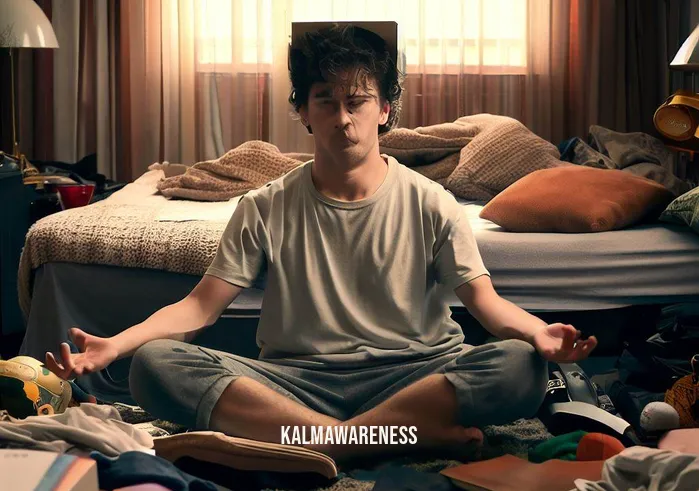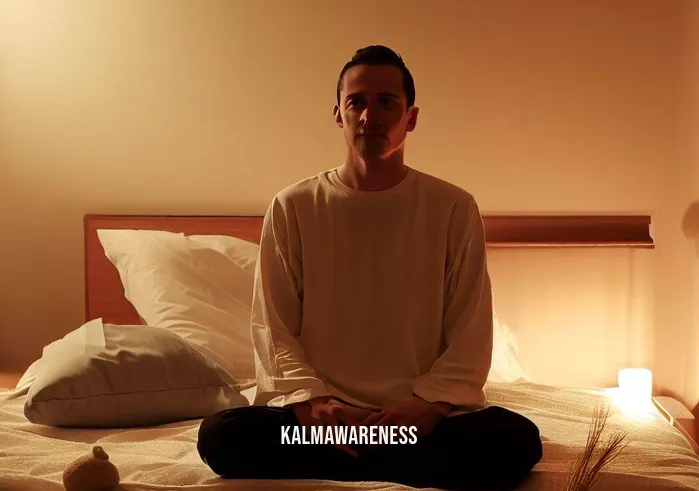Can You Meditate in Bed? Exploring the Intersection of Restfulness and Mindfulness
The question “Can you meditate in bed?” may sound counterintuitive to some, especially if you associate meditation with sitting in a lotus position or attending a yoga class. However, as you’ll soon discover, there is a strong correlation between your bedtime environment and the efficacy of your meditation practice. Moreover, meditating in bed can offer a multitude of benefits, ranging from improved sleep quality to enhanced relaxation and mindfulness.
The Bed as a Sanctuary for Mindfulness
When we think about the bed, what often comes to mind is a place of rest, a haven where we recharge our bodies and minds. In essence, our beds are already associated with peace and relaxation. Incorporating meditation into this environment only serves to enhance the experience of restfulness, thereby reinforcing the involves attaining a peaceful state of mind in which thoughts are not occupied by worry.
It’s an invitation to transform your bedtime into a holistic healing process. Instead of merely collapsing into bed and letting your mind race until you fall asleep, you take the time to mindfully channel your thoughts and feelings, promoting a deeper, more restful sleep.
Does the Posture Matter? Can U Meditate Lying Down?
Traditionally, meditation is often practiced sitting upright to maintain alertness. However, the goal is to find a posture that allows you to stay focused and relaxed simultaneously. Interestingly, the answer to whether can u meditate lying down is a resounding yes. Lying down is an element of some meditation exercises, and it is highly conducive to certain types of meditation like EMDR meditation.
When meditating in bed, the most crucial aspect to consider is your intention. If you intend to relax and eventually drift off to sleep, a lying-down posture is not only acceptable but encouraged. This is particularly beneficial if you’re integrating mindfulness practices as part of your bedtime routine, where the goal is to create a seamless transition from a wakeful state to a restful one.
The Role of Breathing and Other Techniques
Breathing is a foundational element of some meditation exercises. Focusing on your breath serves as an anchor for your thoughts, guiding them away from distractions and worries. While lying in bed, one could even combine breathing with techniques like:
- Body Scans: Encouraging mindful movement in sleep, starting from your toes and working your way up.
- Sound Meditation: Incorporating sounds with specific 256 Hz benefits, which may improve sleep quality.
- Guided Visualization: Using tools like mindful hypnobirthing to encourage positive images and sensations.
“The best way to capture moments is to pay attention. This is how we cultivate mindfulness.”
– Jon Kabat-Zinn
Limitations and Considerations
Though meditating in bed has numerous advantages, it’s essential to keep in mind the definition of your goals. For instance, if you’re looking for an energizing meditation to kickstart your day, your bed might not be the best place for that. Techniques that aim to invigorate and energize, such as Rouse Yoga, are often better suited for other settings.
What’s Next?
This article aims to serve as an introduction to the intriguing realm where bedtime and meditation intersect. We’ve touched on how your bed can indeed be a sanctuary for mindfulness and discussed various techniques that can augment your experience. However, there are still many layers to peel back.
Are you curious about how meditation affects different age groups, like teenagers? Do you want to explore more advanced forms of meditation, such as those guided by Jack Kornfield for beginners? Continue reading to delve deeper into these topics and more.

Enhancing Bedtime Through Mindful Practices: An In-Depth Look at Meditating in Bed
Having established that you can meditate in bed, the next logical step is to explore the myriad of methods and techniques that can complement this unique approach to mindfulness. From variations suited to different age groups to incorporating sustainable self-care, the act of meditating in bed offers a diverse range of options for enhancing your bedtime experience.
Why Age Matters: Meditating in Bed for Different Life Stages
It’s important to acknowledge that the effectiveness of bedtime meditation can vary depending on your life stage. For instance, walking mindfulness techniques that are more active may be more appealing to teenagers walking as a form of mindfulness. This contrasts with adults, who may prefer less physically demanding methods.
For Teens
- Quick methods: Given their busy schedules, teenagers may find 15-minute power nap meditations appealing.
- Interactive techniques: Meditation practices that ask the participant to touch that body part can be an engaging way for teens to focus their restless energy.
For Adults
- Focused breathing: Adults, often burdened by stress and responsibilities, may find simple breathing exercises more accessible and relaxing.
- Guided methods: Adults may find solace in Jack Kornfield’s meditation for beginners, especially if they are new to the practice.
A Table of Techniques: Customize Your Bedtime Meditation
Incorporating meditation into your bedtime routine is not a one-size-fits-all endeavor. Here is a table to help you choose a meditation method based on your needs:
| Meditation Technique | Duration | Best Suited For | Key Benefit | Link |
|---|---|---|---|---|
| Power Nap Meditation | 15 Minutes | Busy Individuals | Quick Refresh | 15-minute power nap |
| EMDR Meditation | 20 Minutes | Stress Relief | Emotional Processing | EMDR meditation |
| Touch Body Part | Variable | Engaging the Mind | Focus | Touch that body part |
| Guided Visualization | 30 Minutes | Creative Minds | Enhanced Imagination | Mindful hypnobirthing |
| Mindful Breathing | 10 Minutes | Everyone | Calmness | Element of some meditation exercises |
Consistency and Long-Term Benefits: The Importance of Sustainable Self-Care
While it’s essential to consider the immediate effects of bedtime meditation, we should also ponder its long-term benefits. Practicing meditation as a form of sustainable self-care can contribute not just to better sleep but also to a more balanced life. For example, meditation made simple techniques can be easily implemented every day, proving that you don’t need to invest hours for an impactful meditation session. You can even have one for each blessed day, making it a part of your daily routine.
Words of Wisdom: The Judgement of the Wise
Taking time to integrate mindfulness into your bedtime ritual is akin to what is often called the judgment of the wise. It’s a conscious decision to prioritize your well-being and make the most out of your rest period, rather than letting it be an afterthought.
“Rest when you’re weary. Refresh and renew yourself, your body, your mind, your spirit. Then get back to work.”
– Ralph Marston
What’s On the Horizon?
This chapter aimed to provide you with a deeper understanding of the different aspects of meditating in bed. From tailoring the practice to your age to exploring various techniques, we’ve covered a lot of ground. However, there’s more to discover, such as the science behind why some techniques work extraordinarily well for relaxation and how they help you get deep into a state of mindfulness so fast. Intrigued? Continue reading to explore these fascinating dimensions further.

The Heart of the Matter: Finding Hope and Inspiration in Bedtime Meditation
Having explored the nuances of techniques and tailored approaches to meditating in bed, let’s shift our focus toward the less tangible but equally significant aspects of this practice: hope and inspiration. After all, one of the most compelling facets of meditation is its ability to touch our lives deeply, uplifting our spirits and filling us with hope.
The Healing Power of Mindful Meditation
Mindful meditation is more than just a relaxation technique; it’s a journey toward self-discovery and inner peace. This transformation is especially pertinent if you’re meditating in bed, where you’re most vulnerable and introspective. The idea involves attaining a peaceful state of mind in which thoughts are not occupied by worry. By incorporating this practice into your nightly routine, you’re essentially choosing to end each day on a note of peace and hopefulness.
“In stillness, the world resets.”
– Unknown
Frequency and Vibration: The Science of Sound in Meditation
Did you know that sound frequencies can significantly affect your meditation experience? The power of 256 Hz benefits illustrates how the right kind of sound can inspire tranquility, particularly when you’re meditating in bed. This is especially important when you’re seeking a practice that not only relaxes but also inspires.
“The quieter you become, the more you can hear.”
– Ram Dass
A Moment for Mindful Movement
Another element to consider for added inspiration is integrating mindful movement into your bedtime meditation practice. You may find that small gestures or sequences can infuse your practice with a sense of purpose and even joy, transforming a relaxation technique into a ritual of hope.
“Your body is precious. It is our vehicle for awakening. Treat it with care.”
– Buddha
Awakening Your Inner Yogi: The Role of Rouse Yoga
Incorporating practices like Rouse Yoga before sleep can be an excellent way to bring hope and inspiration into your bedtime routine. It’s not just about can you meditate in bed, but can you bring other mindfulness practices into your sanctuary of rest to uplift your spirit.
“Yoga is the journey of the self, through the self, to the self.”
– The Bhagavad Gita
Keep in Mind: Definitions Matter
When you engage in bedtime meditation, it helps to keep in mind the definition of the practice. Understanding the intention behind the meditation can inspire you to approach it with a more meaningful perspective. This understanding can fill you with hope, reminding you that each time you engage in this practice, you are taking a moment for yourself, to reset, relax, and inspire.
“The more regularly and the more deeply you meditate, the sooner you will find yourself acting always from a center of peace.”
– J. Donald Walters
A Glimpse Into the Future: The Art of Deepening Your Practice
So far, we have journeyed through the technicalities, customization, and now the emotional richness of meditating in bed. Yet, we have only scratched the surface. In the next chapter, we delve into how to take your practice to the next level, focusing on intricacies like stabilizing your emotional states and advanced meditation techniques for deep, restorative sleep. So, what are you waiting for? Continue reading to unlock the next level of your bedtime meditation journey.

The Essence Distilled: Unpacking the Intricacies of Bedtime Meditation
Having explored the emotional richness and inspirational facets of meditating in bed, it’s now time to get granular. This chapter aims to dissect the practice of bedtime meditation, breaking it down into bite-sized chunks that you can easily digest. Here, we will use bullet points and lists to spotlight the key aspects you should consider when asking, “can you meditate in bed?”
Mastering the Basics: A Refresher
Before diving into the depths, let’s quickly revisit some fundamentals, shall we?
- Breathing: The element of some meditation exercises that brings focus and calm.
- Posture: Though you’re in bed, maintaining a certain level of posture can enhance your meditation.
- Timing: From a 15-minute power nap to a full hour, the length can vary.
- Purpose: Whether it’s relaxation, sleep, or deeper mindfulness, knowing your goal can guide your technique.
Tools and Techniques: A Detailed List
When it comes to meditation tools and techniques you can employ while in bed, the options are abundant:
- Guided Meditations: From Jack Kornfield’s meditation for beginners to more advanced techniques, guided meditations offer a helping hand.
- Breath Focus: Paying close attention to your breath can lead to how we get deep so fast.
- Body Scan: Going through a mental scan of your body parts, a technique sometimes known as “touch that body part”, can be immensely relaxing.
- Visualizations: Picturing peaceful scenes can help you reach a serene state more easily.
- Sleep Aids: Tools like sleep masks or specialized pillows can enhance your experience.
For Different Ages and Stages
Meditating in bed isn’t just for adults; it can be a beneficial practice for all ages.
- Children: Simple visualization techniques can be taught to younger minds.
- Teens: Meditation can be especially beneficial for teenagers walking the tightrope of adolescent challenges.
- Adults: Stress management, better sleep, and improved focus are just a few benefits.
- Seniors: Meditation can aid in combating age-related issues like insomnia or stress.
Sustainability: A Commitment to Self
Maintaining a consistent meditation practice in bed is an act of sustainable self-care. Here are some tips for ensuring that your bedtime meditation routine remains a sustainable practice:
- Be realistic: Start with achievable goals, perhaps meditating for just a few minutes each night.
- Vary your methods: To keep things interesting, rotate between different techniques and tools.
- Incorporate it into your routine: Make it a staple, like brushing your teeth or reading before sleep.
A Glimpse Into the Ultimate Chapter: Making Bedtime Meditation Your Own
This chapter has aimed to break down the seemingly complex practice of bedtime meditation into simpler, more digestible components. Yet, understanding and personalizing this practice are two different things. In the concluding chapter, we will discuss how to tailor your bedtime meditation experience, making it uniquely yours for ultimate relaxation and renewal. Ready for the final reveal? Continue reading to discover how to truly make this sacred practice your own.

The Tranquil Finale: Embracing the Quietude of Bedtime Meditation
Here we are, dear readers, at the peaceful culmination of our journey exploring the question, “can you meditate in bed?” We’ve meandered through the emotional, the inspirational, the practical, and the intricate aspects of this calming bedtime ritual. Now, as we prepare to close this chapter of exploration, let’s take a refreshing look at what we’ve uncovered and where we can go from here.
Revisiting the Core Pillars of Bedtime Meditation
In case you’ve missed any segment or just need a refresher, here are the essential aspects we’ve touched upon:
- Mindfulness: Meditation in bed can take you towards achieving a peaceful state of mind where thoughts are not occupied by worry.
- Techniques: From guided meditation to rouse yoga, there’s something for everyone.
- Sustainability: A consistent bedtime meditation practice is a gift to yourself, a part of sustainable self-care.
Why This Matters: The Last Word on Bedtime Meditation
Meditation in bed isn’t a mere fad; it’s a lifestyle change that offers incredible rewards. Whether you are lying down, seated, or even attempting the EMDR Meditation technique, the central point remains the same: to carve out a space for mindfulness in our hectic lives. In doing so, we stabilize our emotions, foster deeper sleep, and set the stage for waking up to a blessed new day.
Unveiling the Gift of Presence
“The best gift you could have given her was a lifetime of adventures.”
The quote may be about Alice in Wonderland, but it holds true for our journey into the realms of mindful relaxation. The adventures we undertake in the sanctity of our own beds can offer a lifetime of restorative tranquility and emotional balance.
A Toast to Future Endeavors
If you’ve found this journey enriching, then what’s stopping you from diving even deeper? Feel free to explore the realms of mindful movement for sleep or even dabble in mindful hypnobirthing if you’re expecting a bundle of joy! There are infinite avenues to explore in our magazine, and each one offers another piece of the puzzle that is human wellness.
Your Adventure, Our Mission
In closing, we’d like to extend our heartfelt thanks for your time and your interest in delving into the world of bedtime meditation with us. Your exploration doesn’t have to stop here; you can always revisit previous sections for more clarity or stay tuned for future editions brimming with more enlightening content.
On that uplifting note, here’s a heartfelt Thank You for accompanying us on this journey. We’ve equipped you with the knowledge and inspiration you need; now it’s your turn to embrace the tranquil act of bedtime meditation and make it your own.
Go ahead, close your eyes, take a deep breath, and dive into the silent symphony of your inner world. The adventure has just begun.




